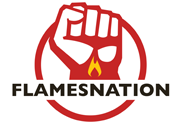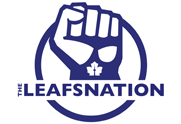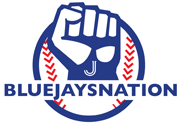Behind "The Code"
Ross Bernstein is a sports author and hockey fan. After hearing over and over again about “The Code”, he decided to ask what it is, and he did just that. Bernstein asked everyone who’s ever looked at a hockey stick about fighting in hockey and the code. The end result was The Code: The Unwritten Rules of Fighting and Retaliation in the NHL, a collection of quotes and opinions from hockey insiders along with Bernstein’s thoughts and the lessons he learned while speaking with the experts and viewing the game with a new sense of its inner workings.
I spoke with Bernstein about how the book was developed and how it changed his outlook on the game.
Singer: How did you think of the idea of writing The Code and when did it materialize as something you were actually going to do?
Bernstein: Well, it took two years to write and I’ve written about 35 sports books. That’s all I do. I’ll just give you my history. I’m from Minnesota and I was a walk-on at the University of Minnesota , and I didn’t make it. I got cut and I became the mascot, Goldy the Gopher, and that experience inspired my first book which was “Gopher Hockey by the Hockey Gopher.” The history of Gopher hockey from this big, smelly rodent’s perspective and it was like a cult bestseller back in ’92 when I graduated from college.
Since then I’ve lived in Chicago and New York for about five years… I moved back home to pursue my dream of becoming a full-time writer, and that’s what I’ve done now for the past ten years. And I’ve written a lot of different hockey books. The other bestseller that I’ve got out right now is called ‘ America ‘s Coach’, a book about Herb Brooks that I was working on with Herbie when he died.
So that’s kind of my background.
I guess the flashpoint for this particular book was the McSorley incident, because they kept saying how “he broke the code”. I consider myself to be a pretty knowledgeable hockey guy – I played at a pretty high level and thought I knew a lot about hockey – but I had no idea what the ‘code’ was.
And then it happened again a year or two later with the Bertuzzi incident. It broke the code. Which seemed more egregious than the act itself.
I’ve got a lot of friends that play pro hockey and during the lockout I practiced with a lot of the guys from the Wild. So I dove in and I wound up interviewing over one hundred people for the book. Mostly heavyweights but a lot of lightweights. Lot of big name people – Gretzky , Brett Hull, Neal Broten – a lot of guys who are protected by the code. And guys in the media and coaches.
And I learned that the code was this living, breathing entity that’s bigger than the game.
I begged my publisher to shelve it for a year during the lockout, because I wanted to see how the new rule changes were going to affect tough guys and the role of the enforcer. And I’m glad I did because the book really, I think it showcases how fighting majors are down 30-40%, whatever the number is exactly right now, post-lockout.
But it’s a different game. The goons are gone essentially. You’ve got to have a guy that can contribute and not be a liability. I personally think that the game is better. I know that a lot of people… would disagree because they like fights. But I think the fights that exist now are more purposeful. They are more meaningful, because you can’t afford to be a guy down, that’s what the “new NHL” is all about. So there are pros and cons.
Singer: When you approached a tough guy and told them you wanted to get some thoughts from them because you were writing a book about ‘the code’, what was his first reaction? What was the typical reaction you got when you said you wanted to write about this unwritten rule?
Bernstein: Well, 90% of the guys were happy to talk to me, and were very cooperative and were actually very grateful. I was really putting them on a pedestal. Really celebrating the honor and courage behind what they do and the selflessness, especially when learning that 90% of their fights were for other people. As Marty McSorley alluded to, in referring to Tony Amonte as ‘the Don King of pro-hockey’, the greatest fight promoter who ever lived: “These guys fight other people’s battles.”
That was what was so amazing to me in the book was learning that, by the time there was an incident where two heavyweights go, there’s a dozen events that existed previously, that I had no idea were going on. In that regard, the book is very enlightening for me now.
I’m credentialed media for Minnesota Wild games, and so I watch the game and I see them much differently. I know that when Derek Boogaard comes out, something’s going on. I know how to follow along when the agitators are out there, trying to get these goal scorers off their game, and force them to take undisciplined penalties. I can see all the different role players doing things and I can see how every little act of disrespect must be held accountable.
In Minnesota , we’re pretty hockey-educated. It’s not like Canada but as far as the lower forty-eight, we consider ourselves along with Michigan and Massachusetts and New York , the hotbeds for folks who grew up playing hockey. We like to think of ourselves as pulling our youngsters out the womb by their skate blades, and all that business.
But it’s been a fun journey, going through it. I’ve had a lot of great success interviewing a lot of these guys before, for other books. I know a lot of them personally. Brett Hull’s written a forward for a previous book as has Wayne Gretzky.
So when I call guys, I come in with a lot of credibility. That I’m not just going to slam them. That I’m not just going to do some horrible expose about how fighting is horrible. They know me and having said that, I’ve had great access.
Singer: When you were speaking to players about the code, what was the main difference between the tough guy perspective and the star perspective, for example a Wayne Gretzky or a Brett Hull?
Bernstein: Well, I didn’t talk to Wayne a lot about it because he sort of deferred, because he’s a coach right now and really can’t talk a lot about that. But Brett Hull was very candid. Brett equated it to a quarterback taking care of his offensive linemen. And he was very candid about how he was lucky to be protected by the code.
But Brett made sure to point out, ‘Hey, I paid the price to stand out in front of the net’. He said he had the scars to prove it, and he did. He wasn’t a pussy, but he definitely appreciated Tony Twist. He got a lot more space with Tony around there. Guys were not going to mess with Brett when Tony was in there.
But, he definitely said he paid the price for going to the net. He got hacked and whacked a lot, and he didn’t play like a jerk. And I think that’s the premise of the code… if you play like a jerk, what comes around goes around. And I think Brett played the game with respect and I think he was treated as such.
But there was a great story too. I love this story, about Neal Broten and Gretzky getting in that fight. And you know, they were both lightweights so they let them go. But Neal said he was in the penalty box and ten guys skated by and looked at him and scowled and said ‘You’re dead!’ And he looked up and realized that half of those guys were his own teammates.
Because now they realized that they were going to have to face Semenko and McSorley and all these other tough guys from Edmonton . Because that’s how it worked – you touched Gretzky and there was hell to pay.
Even though that was a fair fight, there were ramifications.
Singer: A lot of time the media will write about fights and they’ll say whether or not something had a purpose, or whether or not it’s a sideshow. Do you think sometimes there’s more to it than what they’re writing? Sometimes the sideshow fights might not really be the sideshow fights they think they are?
Bernstein: I think there’s so much more to these things. I think I listed twenty reasons in the book why there’s fighting in hockey. From protection to intimidation to retaliation to swinging momentum. You know, the only really spontaneous fights are when you run into a goalie or you do something very, very disrespectful and it has to be mitigated right there on the spot. If you do something really bad, you’ve got to be accountable. That’s really the only flashpoints.
Otherwise, every other fight is pretty pre-meditated. You know, guys have to agree – they don’t want an ‘instigator’, so they both have to mutually agree. I talked to a lot of linesmen and they’re part of it, too. They know what’s going on, and they say ‘yup, you guys fight.’
Part of the book’s goal was to educate everyone else. When I talk to guys like you, you’re absolutely the pinnacle. You’re the crème de la crème of experts in this field. I’m not going to write a book and tell you a lot of things you don’t already know. But I hope to educate a lot of other people because and I think that’s been the overwhelming response, why the book has sold so well, internationally.
Singer: It seems that you didn’t write the book much from your own perspective. A lot of it really seemed to be tying together the stories and the thoughts of all the players that you were talking to. You interviewed just about everybody, so it’s like you let it write itself, in a way.
Bernstein: I did, I did. Some people can take offense to that because that’s not the way they would’ve done it and I respect that. It’s like turning in a freshman composition paper when you’re in college. You’re going to get ten different grades from ten different professors.
Everybody has a way that they would do it. I tried to make it sort of like Switzerland. I offered really good arguments for fighting and really good arguments against fighting. My opinion is, I’m for fighting, but I realize the honor behind why there’s fighting. I’m not a big fan of the gratuitous fighting, like the ‘guaranteed fight night’ in the minor league cities, however.
Singer: Do you find it a little ironic that as a lot of fighting has been phased out over the past decade and a half, a lot of the reason for it was said that they need to sell the game to America and one of the ways they want to do that is to sell a clean game.
Bernstein: It’s the catch-22 of hockey, isn’t it? I mean, if you were to eliminate fighting, would you get a national television contract? I don’t know. If you keep fighting, are you never going to get a national television contract? I don’t know. Hockey’s not like football. They don’t make a billion dollars before they open the doors every year. It’s localized.
I think almost 70% of revenue from hockey comes from the fans. It comes from tickets and beer and parking and jerseys. So, you have to take care of the fans that come. It’s not like football where can you don’t have to worry about the 75,000 fans in the stadium as long as you satisfy the 20 million watching at home.
There aren’t 20 million watching at home in hockey, that’s just the nature of the beast. Particularly and especially in places like Carolina and Phoenix . So you have to make it a sellable product.
Singer: When you interviewed people again after the lockout came to an end to ask them about the new rules, do you think people liked them? The comments in the book seem to be overly positive. But did it seem like they were genuinely liking it? Or did it seem like they were feeding you a company line?
Bernstein: Well, all I can tell you is, I think it was ‘all of the above’. Everything that you presented, I think it was a little bit of everything. It could’ve been some company line, it could’ve been some ‘wait and see, we don’t know yet’. All I can say is that those were the honest answers I got. I guess you’ve got to take that for what it’s worth. I try and get a cross-sampling of a lot of different players.
I did talk to a few current players. A lot of the current guys couldn’t really talk a lot about the code. For example, I met Tie Domi after a game one night in the locker room and he just said, ‘I’m not cool talking about a lot of this stuff right now’.
But the one thing that was the overwhelmingly common denominator was how they all hate the instigator, how that’s ruined the game. I think you definitely saw that come screaming out of the book.
But as far as new rules, I still think it’s a little bit of a ‘wait and see’… because with the combination of the salary cap and the fact that there’s no red line, you’re going to see a lot more Tie Domis going by way of the dinosaur because they can’t afford those contracts.
You know, Tie was a very lucky guy in that he was a very popular figure in Toronto – which, if you’re from Canada , is the place to play. And, even though he was an enforcer, he got to take a regular shift.
Singer: In general, since you’ve interviewed so many sports figures, how would you compare the typical NHL player towards to those players in other sports?
Bernstein: They’re the most real, down-to-earth guys. When hockey players get rich, they buy new SUVs and fishing boats. They don’t live the lifestyle of basketball players or football players. They’re a totally different animal. I’ve written all different sports books for different sports. I’ve written biographies on everyone from Barry Bonds to Kevin Garnett.
And hockey players don’t let guys get too big for their britches. They’ll just get beat up or abused by their teammates. They don’t drive fancy cars. And you know what? Most of them come from pretty modest, humble places. That’s just not their nature.
Unless they move to New York and ‘live the life’, a lot of them just don’t live that way. They’re pretty quiet guys.
Singer: Do you feel that that actually hurts the NHL at the same time? Is it harder to market their quiet personalities off the ice?
Bernstein: Well, I think so, and I think you’re seeing the Russian and the foreign influence certainly hurt the game. And I think that nowhere is there a better example of this than in women’s golf, which has exploded because of young, beautiful women… they televise well, and that’s what sponsors want.
And there were some women who got furious when they were talking about how they didn’t want the South Korean women to make headway into the game, because they didn’t learn the language, they weren’t beautiful, and that didn’t sell corporate sponsorships. And these aren’t my words, that’s theirs.
It’s a reality of what sells. And if you don’t have ‘characters’ you have nothing to sell. Even Sid Crosby and Ovechkin, you don’t hear from them very often.
Hockey was always lucky that you could see their faces and get to know them, unlike football, and I think the league needs to do a better job of selling those people and their personalities.
The problem, too, with hockey right now is that they did all this crazy realignment. Why did they put Minnesota with all these crazy western Canadian cities. I mean, we should be back with the old Norris, with Chicago and St. Louis and Detroit . That was what the fans wanted. That’s what made good rivalries, and everyone talks about the rivalry with Colorado and Detroit . Why? Because there were some fights, and that was when hockey was interesting
A goalie fight. There is great drama there.
All of the expansion and these new, non-traditional bases have just killed it. Half these games with Edmonton , all these kids in Minnesota go to bed too early to watch the end of the game. I think that’s hurt the game, too.
So it’s a combination of all those things.
Singer: In terms of fighting and marketing, the NHL doesn’t market fighting at all. Some of the teams might take it upon themselves to include an image or footage of a fight in a local commercial. But on a national level, the NHL has never embraced it. Should the NHL just say, ‘this represents something that fans like’ and include it in their marketing? Or should they keep ignoring it to try and appeal to a wider audience.
Bernstein: I’ve heard from a lot of sort of ‘undisclosed high sources’, so to speak, a lot of people in the NHL loved my book because it tells people why there’s fighting. They’ve never done a good job explaining it…
I’ve sort of explained this thing in laymen’s terms that people can understand and it’s not coming from some proclaimed ‘expert’. I don’t claim to be an expert, I’m a fan, but I really wanted to tell the story. I do all these TV and radio interviews and I tell everyone about it, and they are like ‘Wow, that’s fascinating, That’s enlightening. I watch the game, and it’s so much better now’.
Well, if you understand the fighting and understand why it is, it makes it so much more enjoyable. I think there’s some truth to that. They could market it that way and say ‘Oh, the reason there’s a fight is because this guy did this really dirty thing, he high-sticked that guy. And now the enforcer came out to keep the peace.’ If they would only explain it…
People read about the Bertuzzi incident, they go ‘oh no’. All they saw was the last thirty seconds of a two week mini-series. They saw a guy jumping a guy from behind. That’s all they see and they go ‘Oh, those fucking hockey players. They’re jerks.’
Singer: At the same time, the Bertuzzi incident is one of the few instances where someone clearly broke every aspect of the code you can really think of. How many players said something like the Bertuzzi incident had nothing to do with what we do and what the code is all about? Did anybody comment on anything like that?
Bernstein: Most of the guys came to Todd’s defense. They said, Todd’s not a dirty player. Todd’s not a fighter. Todd was standing up for the honor of Naslund, and didn’t feel like Moore ‘s punishment fit the crime.
[But Bertuzzi] definitely broke the code in every way. And because he jumped on him and broke his neck it was magnified times a million.
But the reality that I wanted to show too, was that Moore broke the code as well. I’m not taking Bertuzzi’s side, but I wanted to show the intricacies of the code. I think everybody said Todd was definitely at fault. But I also think that most people said that Todd was not a vicious guy, he probably didn’t want to hurt him, but it was very emotional, heated game.
Moore really took out Naslund and [Bertuzzi] wanted to get him back. And it festered and grew and the next game Bettman was in the audience and they couldn’t do anything, and there were playoff points on the line… Then all of a sudden it’s a blowout.
Why did Coach Crawford have Bertuzzi in there? I want to show the accountability in other places. It’s not like the lunatics are running the asylum. The coaches are completely involved in this.
I want to show that this all goes on. It’s a system. And I’m not saying it’s bad, I just want to say this is how it works.
Singer: Do you think these incidents would still happen whether or not they attached a game misconduct to a fight and threw out a player for fighting? Would players still feel that they need to take certain things into their own hands?
Bernstein: I think teams would get guys cheap and just keep them on their roster and just send them out to fight and then they would just say we’re just going to have one less guy on the roster. Suppose if in Minnesota , someone just wants to beat the shit out of Marian Gaborik or Pavol Demitra or Brian Rolston? [Then] we’ll send a guy out there to destroy him, let him take a suspension and we’ll pay. Teams can’t know they can do that to us.
One of the reasons I think they can never eliminate fighting from hockey is because they can never bring it back.
But at some point you have to wonder if and when someone dies because of a fight, that’s what it’s going to be over. Because I’m frankly shocked that no one’s dead. You know, 100 years of pro hockey, in all the research I did, all the fights and the stick fights and how hard these guys fight…
You look at boxing and every year there’s at least two or three people that die, with a brain aneurism or something, and really it’s just incredible that someone doesn’t get hit right on the button at some point and just die.
Singer: I think it’ll happen when somebody’s head hits the ice the right way. It really seems to be where all the most serious injuries are coming from in fights. When it’s not a broken bone, like broken cheek bone, it always seems to be the concussion that just lasts forever.
Bernstein: There was one death, Bill Masterton, he was from Minnesota . He got checked, hit in the back of the head like you said, and he died. If it happens [in a fight], you hope it happens in Canada because with the people up there, the trial would be much more forgiving. But if it happened in say San Jose , all of a sudden some guy dies and it goes to jury, then that guy, that enforcer, could go to prison, for doing his job. And then how do you not sue the NHL for allowing that environment?
I don’t know how it works, but I tried to list a lot of legal precedent in the book, to show all these instances of what happens. These enforcers really lay it on the line even beyond the possibility of getting injured every day
Look at Bertuzzi: who knows what’ll happen in that whole instance. It’s still in court. Again, Todd Bertuzzi was not an enforcer. He was standing up for the honor of one of his teammates.
Singer: And he’s still being called a goon by many, just for doing that.
Bernstein: What he did was totally wrong, I don’t want to defend it at all. I just wanted to explain both sides, and I hope I did that.
Singer: You said that many players that are still in the game obviously couldn’t open up quite as much as the players who are now out of the game. One of the new rules last year was, fight in the last five minutes regulation and get an instigator, and you’re suspended automatically. You get a fine, your coach gets a fine. Did anybody speak about that rule?
Bernstein: I talked about it a little bit. I talked to the Wild’s coach Jacques Lemaire since one of the first team’s to be penalized that rule was the Wild last year. And Jacques is not one of those kind of coaches. He’s more fundamentally disciplined. He’s not the kind of guy that’s going to send a guy out there to goon it up. But he got that $10,000 fine right away, one of the first guys to get it. He talked about it a little bit. It was a situation that the player felt it was worth it because it was more of a team fight. They had to send a message. And I think it was even a tight game. But they said, ‘you know what, we had to stand up for ourselves.’ That was important.
Singer: Did you feel the current players are content with the way things were? As you mentioned, they weren’t thrilled with the instigator. Was there anything else that they mentioned, that they wished was changed?
Bernstein: Well, I think from talking to Derek Boogaard, he’s a lucky guy. He plays in a city that loves him. All these enforcers are usually the most loved guys on the team. Fan favorites obviously. Everyone loves the tough guy, they love the protector. But I think with Derek, I think he was really happy with a lot of it, because a lot of the game has been cleaned up
It’s kind of a catch-22, actually. You know, the cleaner game, the less ice time for Derek Boogaard? It means less fighting.
That reminds me of a story from the book about how something that was seemingly good really had an impact on the enforcer’s job. I interviewed Tom Chorske, the New Jersey Devils radio analyst. He played about ten years with New Jersey and Montreal .
He was a goal-scorer but one night he lost his cherry, his fighting cherry when he wanted to stand up for himself, and an agitator was hacking him and he just dropped the gloves and went at it. He didn’t win the fight but he “showed up”, and his teammates all banged their sticks on the boards and they were proud of him. And after the game they all whacked him on the shin pads, ‘Hey, way to go kid, way to go’, because that’s how you earn respect. Prison justice mentality. You stand up for yourself otherwise someone will make you their girlfriend.
Well, afterwards he congratulated him. And as everyone was milling out of the locker room, the team enforcer came over to him and said ‘Tom, don’t ever fucking do that again.’ He said, ‘That’s not your job. If teams know they can whack you and you’ll take an undisciplined penalty, you’re going to put the team at a disadvantage. That’s selfish. Secondly, I can’t do what you do. So you can’t do what I do too. They measure your contract by goals and assists, they measure mine by penalty minutes. Don’t ever fucking do that again because that’s my job. You’re going to cost me a job.’
I thought that was fascinating. You take that a step further, I guess, with Derek Boogaard, and he’s only got, what, six fighting majors so far? And that’s not very many.
Like Tony Twist said, too, he became so tough and fierce in his day, he almost cost himself a job. He joked that he could put a cardboard cutout of himself at the end of the bench and it would have the same effect. No one was going to fuck with this guy because he was so feared.
And you wonder, if the new rules change the game that much, [if] these guys totally will become a dying breed. I don’t know. I mean, I think they’re necessary, but teams used to have two or three tough guys, now they only have one.
I think the new way of the game will be the Sean Avery type players, the bigger agitator, tougher guys that can take care of themselves and can fight if they have to.
Singer: You’ll still probably see a lot of Todd Fedoruk-type players. A guy who’s very willing, still a heavyweight through and through, but he can skate. When he went to Anaheim they certainly weren’t afraid to give him some ice time there and he put some points up. As the evolution continues like that, I don’t know if fighting’s really going to die off too much.
Bernstein: Yeah, I hope not. I really think it has a place in the game, but I don’t think we’re going to see the full effect from the lockout with the salary cap and the new rule changes, with the red line, and the cut-down of obstruction and so forth, for really another year or two. Until a lot of these big contracts dry up, like Domi’s for instance.
Singer: You might see a new breed of tough guy work its way up from the junior leagues. Players cannot aspire to reach the NHL only with the fists anymore. Tough guys have to learn how to play the game, and now that players in juniors see that a player with toughness and skill may be at a premium in the NHL, those types of players will start being produced. But it may take several years. Does that seem like a possibility in your eyes?
Bernstein: That’s a good point. Derek Boogaard talked about being a bantam and jumping into a team bench and taking on the entire team and they all put up their hands like they were under arrest. And sure enough, he got called up to the next level. And he was all excited because he showed how tough he was and that’s where it starts. It all starts with the juniors. The code, that’s where it begins.
But all those guys, they don’t dream of making it as a fighter. They dream of scoring the game winner in game seven for the Stanley Cup. They all dream of that. But then at a certain point they realize they can make it as this role of a fighter, and that’s their role. They’ll take it, it’s a job.
It’s interesting, I wrote a book last year about Gopher hockey, and really, the state of college hockey, and I interviewed a hundred college hockey players who had gone on to play pro. And a lot of those players, I asked them, why aren’t more college guys making the jump to professional. And resoundingly, they said there’s such a leap from college to pro. They basically said each of these guys is going to have to take a few years, to go cut their teeth in the minor leagues and pay their dues. And they said, a lot of these guys realize that they might not be that great, and they are going to need to drop the gloves.
And when you’ve got a college degree to fall back on, you’re not as tough as the kid from Moncton or Moose Jaw that realizes ‘You know what, I have to make it. I’ve got nothing to fall back on’ other than a job in a salt mine or whatever. That is a huge factor of why a lot of those kids will do whatever it takes.
Singer: And what does it take?
Bernstein: Well, I thought the whole ordeal of saying, ‘Excuse me, Mr McSorley, I’m trying to make the team. Could a please have a fight with you, sir, show the coaches what I can do?’ was fascinating.
And what a double edged sword for McSorley. It’s a lose-lose. If the guy beats him, McSorley might be out of a job. And if the guy doesn’t beat him, he’s got nothing to lose, he wasn’t expected to. But then McSorley’s got to go get beat up his face with nothing to show for it.
You know, that’s part of the code. These guys don’t want to hurt each other because they know that there’s five guys waiting in the wings to take their job, and they’re all in the same boat.
Like Boogaard said after his fight with Fedoruk. He said, ‘I felt bad, man. That guy could be out a long time.’ You don’t know what’s going to happen. He went right to the hospital for emergency surgery that night. None of them want to cost anyone’s livelihood, they just want to win the fight and swing the momentum.
Singer: Well, it’s not like Fedoruk hasn’t been through that before.
Bernstein: Yeah, they’ve all been through it, they all go through it. I just think that their job is just amazing. How they do this, what they do. How they go home and put their kids to bed, read stories at night.
Singer: Another thing you mentioned in the book was explaining fighting to kids. How they try and explain what they do to kids, and why fighting is different in hockey than it would be at a school yard. What was your reaction to some of those quotes?
Bernstein: I was just curious because I always heard that asked of them because hockey players and fans view hockey fighters like “you’re honorable and you’re a warrio









